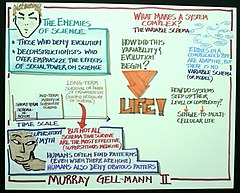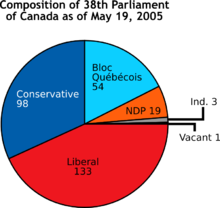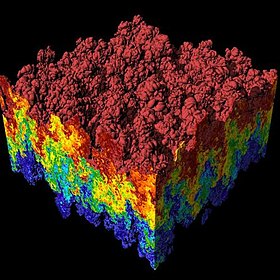User:Mdd/Visualization
| This is not a Wikipedia article: It is an individual user's work-in-progress page, and may be incomplete and/or unreliable. For guidance on developing this draft, see Wikipedia:So you made a userspace draft. Find sources: Google (books · news · scholar · free images · WP refs) · FENS · JSTOR · TWL |
| It has been suggested that this page be merged into Visualization. (Discuss) Proposed since January 2022. |
- For other uses, see Visualization (disambiguation)

Visualization is "the formation of mental visual images, the act or process of interpreting in visual terms or of putting into visual form."[1]. It is "the graphical display of information. The purpose of this graphical display is to provide the viewer a visual means of processing the information."[2]
Visualization, in the sense of "the act or process of interpreting in visual terms or of putting into visual form", has been used in maps, technical drawings, and data plots for over a thousand years.[1]
Overview[edit]
The term visualisation[edit]
According to the Merriam-Webster's Collegiate Dictionary (2004) the term visualisation originates from the year 1883, and has three distinguished meanings:
- "1 : formation of mental visual images
- .2 : the act or process of interpreting in visual terms or of putting into visible form"
- .3 : the process of making an internal organ or part visible by the introduction (as by swallowing) of a radiopaque substance followed by radiography."[3]
Linda M. Phillips, Stephen P. Norris, John S. Macnab. Visualization in Mathematics, Reading and Science Education. 2010. p. 22.
Definitions of visualisation[edit]
Robert Kosara (2007) explained:
- "A good part of the confusion about visualization comes from the fact that there is no clear or generally accepted definition of visualization. Such a definition would clearly vary between fields, but at least within one field (like computer science, design, illustration, etc.)..."[4]
Hereby Kosara (2007) made the following distinction in visualisation:
- "Two cultures exist in visualization: very technical, analysis-oriented work on the one, and artistic pieces on the other hand.[4].
This article will focus on the first: the technical, analysis-oriented work.
The act of generating images[edit]
Visualization is an old term which has previously been defined as:
- "the formation of visual images; the act or process of interpreting in visual terms or of putting into visual form."[1]
More recently in the computer science community a new definition has been added:
- "A tool or method for interpreting image data fed into a computer and for generating images from complex multi-dimensional data sets".[1]
In 1999 Stuart K. Card defined visualization as the
- "use of computer-supported, interactive, visual representations of data to amplify cognition".
In this line he defined information visualization as the
- "use of computer-supported, interactive, visual representations of abstract nonphysically based data to amplify cognition".[5]
Cognition is hereby seen as the acquisition or use of knowledge. The purpose of visualization is insight, discovery, decision making and exploration.
In this approach Information visualisation focusses on increasing our ability to perform these and other cognitive activities. Visualisation as a organized subfield of computer science dates from the Nation Science Foundation report "Visualization in Scientific Computing" by B.H. McCormick and others from 1987. The focuss on tools to permit handling large sets of scientific data and the enhancement of the ability to see phenomena in data resulted in the field of scientific visualisation.[5]
Visualization and communication[edit]
In short visualization is the graphical display of information. To be effective visualization must draw upon the knowledge base of the viewer. If the viewer does not posess the knowledge to understand the graphical entities and the relations between them the visualization does not achieve its goal. Visualization has many applications according to Steven Segenchuk (1997), which can be classified into two categories:[2]

- Data Exploration: the practice of using visualization techniques to find unforeseen relationships between data points or sets of points in large databases.
- Communicating Information: the application of visualization techniques to communicate information that is already known.
There is a minimal set of requirements for any visualization, which apply equally to information visualization and scientific visualization[4]. These criteria are:
- It is based on (non-visual) data. The data to be visualized must come from outside the program, and the program must be able (at least in principle) to work on different data sets. Also, visualization is not image processing or photography; if the source data is an image and is used as an image in the result, it is not being visualized[4].
- It produces an image. Clearly, each visualization has the goal of producing one or more images from the data, and the visual must be the primary means of communicating the data. Other media can be part of a visualization, but the visualization must be able to stand on its own[4].
- The result is readable and recognizable. There are many ways to transform data into images, most of which do not allow the viewer to understand the underlying data. A visualization must produce images that are readable by a viewer, even if that requires training and practice. Visualization images must also be recognizable as such, and not appear to be something else[4].
History[edit]
Visualization, in the sense of the act or process of interpreting in visual terms or of putting into visual form, has been used in maps, technical drawings, and data plots for over a thousand years.[1]

The earliest known map is a matter of some debate, both because the definition of "map" is not sharp and because some artifacts speculated to be maps might actually be something else. A wall painting, which may depict the ancient Anatolian city of Çatalhöyük, previously known as Catal Huyuk or Çatal Hüyük, has been dated to the late 7th millennium BCE.[6] The ancient Greeks and Romans created maps, beginning at latest with Anaximander in the 6th century BC. Ptolemy's world map is a map of the known world to Western society in the 2nd century A.D. As early as the 700s, Arab scholars were translating the works of the Greek geographers into Arabic.[7]
In ancient China, geographical literature spans back to the 5th century BC. The oldest extant Chinese maps come from the State of Qin, dated back to the 4th century BC, during the Warring States Period. In the book of the Xin Yi Xiang Fa Yao, published in 1092 by the Chinese scientist Su Song, a star map with cylindrical projection similar to the later and apparently, separately invented, Mercator projection. Early forms of cartography of India included legendary paintings; maps of locations described in Indian epic poetry, for example, the Ramayana. Indian cartographic traditions also covered the locations of the Pole star, and other constellations of use. These charts may have been in use by the beginning of the Common Era for purposes of navigation.

The beginning of contemporary engineering drawing originates from 15th century renaissance artists like Filippo Brunelleschi, who in about 1415 demonstrated the geometrical method of perspective, used today by artists, by painting the outlines of various Florentine buildings onto a mirror. Leonardo da Vinci further developed perspective and technical drawing, using geometric principles from famous Greek mathematicians like Pythagoras of Samos, and Euclid of Alexandria.
The earliest seeds of data visualization arose "in geometric diagrams and in the making of maps to aid in navigation and exploration. By the 16th century, techniques and instruments for precise observation and measurement of physical quantities were well-developed— the beginnings of the husbandry of visualization. The 17th century saw great new growth in theory and the dawn of practice— the rise of analytic geometry, theories of errors of measurement, the birth of probability theory, and the beginnings of demographic statistics and “political arithmetic”.[8]

Over the 18th and 19th centuries, numbers pertaining to people—social, moral, medical, and economic statistics began to be gathered in large and periodic series; moreover, the usefulness of these bodies of data for planning, for governmental response, and as a subject worth of study in its own right, began to be recognized.[8]
Computer graphics has from its beginning been used to study scientific problems. However, in its early days the lack of graphics power often limited its usefulness. The recent emphasis on scientific visualization started in 1987 with the special issue of Computer Graphics on Visualization in Scientific Computing. Since then there have been several conferences and workshops, co-sponsored by the IEEE Computer Society and ACM SIGGRAPH, devoted to the general topic, and special areas in the field, for example volume visualization.
Types of technical graphics[edit]
Computer graphics[edit]

Computer graphics are graphics created by computers and, more generally, the representation and manipulation of pictorial data by a computer. The term computer graphics includes almost everything on computers that is not text or sound. Today nearly all computers use some graphics and users expect to control their computer through icons and pictures rather than just by typing.[9] The term Computer Graphics has several meanings:
- the representation and manipulation of pictorial data by a computer
- the various technologies used to create and manipulate such pictorial data
- the images so produced, and
- the sub-field of computer science which studies methods for digitally synthesizing and manipulating visual content.
Today computers and computer-generated images touch many aspects of our daily life. Computer imagery is found on television, in newspapers, in weather reports, and during surgical procedures. A well-constructed graph can present complex statistics in a form that is easier to understand and interpret. Such graphs are used to illustrate papers, reports, theses, and other presentation material. A range of tools and facilities are available to enable users to visualize their data, and computer graphics are used in many disciplines. [10]
Chart[edit]

A chart is a visual representation of data, in which the data are represented by symbols such as bars in a bar chart or lines in a line chart.[11] A chart can represent tabular numeric data, functions or some kinds of qualitative structures. The term "chart" as a visual representation of data has multiple meanings.
- A data chart is a type of diagram or graph, that organizes and represents a set of numerical or qualitative data.
- Maps that are ardorned with extra information for some specific purpose are often known as charts, such as a nautical chart or aeronautical chart.
- Other domain specific constructs are sometimes called charts, such as the chord chart in music notation or a record chart for album popularity.
Charts are often used to ease understanding of large quantities of data and the relationships between parts of the data. Charts can usually be read more quickly than the raw data that they are produced from. They are used in a wide variety of fields, and can be created by hand (often on graph paper) or by computer using a charting application.
Diagram[edit]
Illustration[edit]
Map[edit]
Plot[edit]
Technical drawing[edit]
More specific technical graphics[edit]
- Visualization methods/techniques
And:
- Projection...??
Fields of visualization[edit]


Data visualization[edit]
- Data visualization is the science of visual representation of “data”, defined as information which has been abstracted in some schematic form, including attributes or variables for the units of information. This topic could be taken to subsume the two main focii: statistical graphics, and thematic cartography.[8]
- Notable scientists Michael Friendly, Edward Tufte ...??
Information visualision[edit]
- Information visualization is generally applied to the visual representation of large-scale collections of non-numerical information, such as files and lines of code in software systems, library and bibliographic databases, networks of relations on the internet, and so forth.[8]
- Notable scientists are Stuart K. Card, Jock D. Mackinlay, George G. Robertson and Ben Shneiderman.[14]
Geovisualization[edit]
- Cartographic visualization is primarily concerned with representation constrained to a spatial domain; statistical graphics applies to any domain in which graphical methods are employed in the service of statistical analysis.[8]
- Notable scientists are Alan MacEachren
Scientific visualization[edit]
- Scientific visualization is another present field, primarily concerned with the visualization of 3-D+ phenomena (architectural, meterological, medical, biological, etc.), where the emphasis is on realistic renderings of volumes, surfaces, illumination sources, and so forth, perhaps with a dynamic (time) component.[8]
- Notable scientists are Bruce H. McCormick, Thomas A. DeFanti, Maxine D. Brown, Clifford A. Pickover, and Lawrence J. Rosenblum.[15]
Other fields[edit]
- Business Information Visualization: Business Information Visualization is a relatively new field and has just started to gain researchers' and practitioners' attention. Similar to Scientific Visualization and Information Visualization, it is intended to consider human cognition and perception characteristics and provide insight into data by computer generated visual representations. However, owing to the nature of business data, Business InformationVisualization faces special challenges such as dealing with non-geometric data and incorporating human problem-solving processes. In research and practice, there is a need to understand the specific challengesof visualizing business data and the procedures of how to do it.[16]
- Creative visualization
- Chemical imaging
- Crime mapping
- Educational visualization
- Flow visualization
- Interactive visualization
- Medical imaging
- Music visualization
- Product visualization
- Software visualization
Related fields[edit]
Scientific modeling[edit]
Visual arts[edit]
Visual communication[edit]
Visual communication is the communication of ideas through the visual display of information. Primarily associated with two dimensional images, it includes: alphanumerics, art, signs, and electronic resources. Recent research in the field has focused on web design and graphically oriented usability.
Visual perception[edit]
Visual system[edit]
Visual thinking[edit]
See also[edit]
- Category:Media theorists
- Data visualization
- Information visualization
- Scientific visualization
- Visual analytics
References[edit]
- ^ a b c d e G. Scott Owen (1993). "Visualization Education in the USA". In: Journal of Computers and Education. Vol. 8, pp. 339-345.
- ^ a b Steven Segenchuk (1997). "The Role of Visualization in Education". CS563 4/29/97.
- ^ Merriam-Webster (2004), "Visualisation," in: Merriam-Webster's Collegiate Dictionary: Eleventh Edition, p. 1399.
- ^ a b c d e f Robert Kosara (2007). "Visualization Criticism – The Missing Link Between Information Visualization and Art". Information Visualization, 2007. IV'07. 11th International Conference. IEEE, 2007.
- ^ a b Stuart K. Card, Jock D.Mackinlay and Ben Shneiderman (1999). Readings in Information Visualization: Using Vision to Think, Morgan Kaufmann Publishers.
- ^ [1] "A Tale of two obsessed archeologists, one ancient city, and nagging doubts about whether science can ever hope to reveal the past" by Robert Kunzig. Discover Magazine, May 1999.
- ^ History of Cartography
- ^ a b c d e f Michael Friendly (2008). "Milestones in the history of thematic cartography, statistical graphics, and data visualization". Cite error: The named reference "MF08" was defined multiple times with different content (see the help page).
- ^ What is Computer Graphics?, Cornell University Program of Computer Graphics. Last updated 04/15/98.
- ^ ISS (2002). "What are computer graphics?". Last updated: 22 Sep 2008
- ^ Cary Jensen, Loy Anderson (1990). Harvard Graphics: The Complete Reference. p.625.
- ^ National Visualization and Analytics Center. Retrieved 1 Juli 2008.
- ^ Visualizations that have been created with VisIt. at wci.llnl.gov. Updated: November 8, 2007
- ^ Weimao Ke, Katy Borner and Lalitha Viswanath (2004). "Major Information Visualization Authors, Papers and Topics in the ACM Library". In: Proceedings of the IEEE Symposium on Information Visualization table of contents p. 216.1.: The presented work aims to identify major research topics, co-authorships, and trends in the IV Contest 2004 dataset. Co-author, paper-citation, and burst analysis were used to analyze the dataset.
- ^ These scientists listed where the first to publish books about these fields in the 1980s and 1990s.
- ^ Dr. Ping Zhang (2000). [http://melody.syr.edu/pzhang/publications/Encyclopedia_00_01_Zhang.pdf. "Business Information Visualization: Guidance for Research and Practice". Published in: Encyclopedia of Microcomputers, Volume 27, Supplement 6, 61-77, 2001. And in: Encyclopedia of Library and Information Science, Volume 69, Supplement 32, 1-17, 2000.
Further reading[edit]
- Lee E. Brasseur (2003). Visualizing Technical Information: A Cultural Critique. Amityville, NY: Baywood. Publishing.
- Richard Mark Friedhoff and William Benzon (1989). Visualization: The Second Computer Revolution. W. H. Freeman and Company.
- Edward R. Tufte (1983). The Visual Display of Quantitative Information. Graphics Press.
- Robert Spence. (2006). Information Visualization: Design for Interaction (2nd Edition), Prentice Hall.
- Leland Wilkinson (2005). The Grammar of Graphics, Springer.
External links[edit]
- National Institute of Standards and Technology Scientific Visualizations, with an overview of applications.
- NASA Scientific Visualization Studio. They facilitate scientific inquiry and outreach within NASA programs through visualization.
- Reader "Milestones in the History of Thematic Cartography, Statistical Graphics and Data Visualization"
- Scientific Visualization Tutorials, Georgia Tech
- NovoSpark Visualizer - an advanced visualization tool that enables qualitative analysis of multidimensional data through the exploration of a graphical image.
- See also
- User:Mdd/Visualization
- User:Mdd/Data visualization 22 July 2008 became Data visualization
- User:Mdd/Educational visualization
- User:Mdd/Information visualization
- User:Mdd/Knowledge visualization
- User:Mdd/Scientific visualization 12 July 2008 became Scientific visualization
- User:Mdd/Visual analytics 26 June 2008 became Visual analytics
Category:Infographics
Category:Visualization (graphic)
Category:Computational science
Category:Computer graphics
Category:Scientific modelling
Category:User interface techniques

